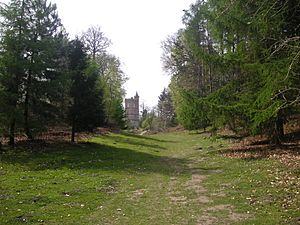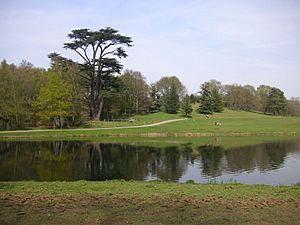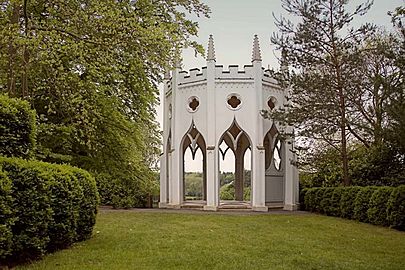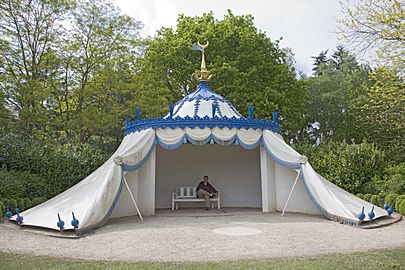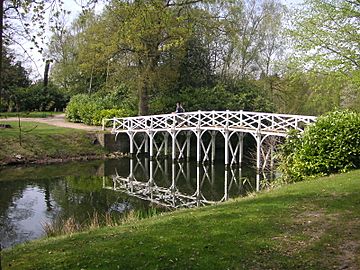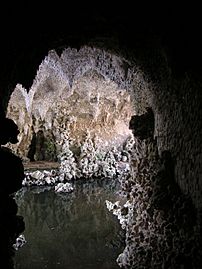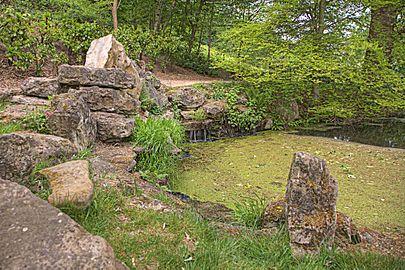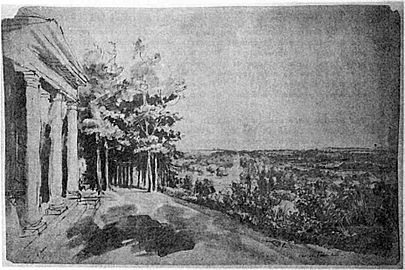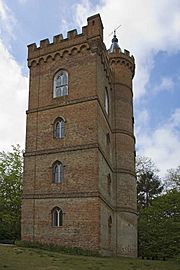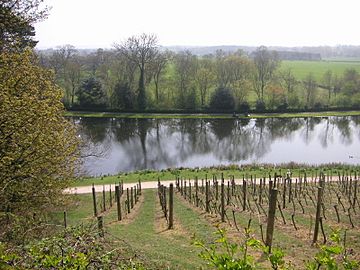Painshill facts for kids
Quick facts for kids Painshill |
|
|---|---|
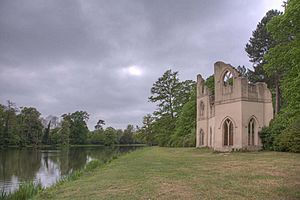
The Abbey: one of the surviving original follies
|
|
| Lua error in Module:Location_map at line 420: attempt to index field 'wikibase' (a nil value). | |
| Location | Cobham, Surrey, England |
| Area | 64 hectares (158 acres) |
| Created | 1738 - 1773 |
| Founder | Charles Hamilton (MP) |
| Owned by | Elmbridge Borough Council |
| Open | Every day (except Christmas and Boxing Day) |
| Collections | John Bartram Heritage Collection |
| Designation | Grade I |
| Connecting transport | South Western Railway |
| Website | http://www.painshill.co.uk |
Painshill, located near Cobham in Surrey, England, is a beautiful 18th-century landscape park. It's considered one of the best examples of its kind. Charles Hamilton designed and built this amazing park between 1738 and 1773. The house he originally built there is no longer standing.
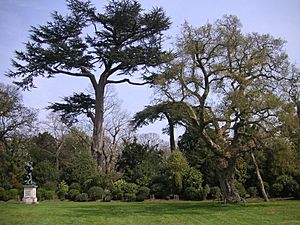
Today, Painshill is owned by Elmbridge Borough Council. The Painshill Trust manages the park. It is open to the public, though there is an entry fee. Painshill is a "Grade I listed" site. This means it's recognized as a very important historic park and garden.
In 1998, Painshill won the Europa Nostra Medal. This award was for its "exemplary restoration." The park was brought back to life from a state of extreme neglect. In 2006, Painshill also received special status for its John Bartram Heritage Collection of plants.
Contents
History of Painshill Park
Charles Hamilton's Vision
Charles Hamilton was born in 1704 in Dublin. He was the 14th child of the 6th Earl of Abercorn. He studied at Westminster School and Oxford. He also traveled around Europe on two "Grand Tours."
In 1738, Hamilton started buying land at Painshill. Over time, he owned more than 200 acres (81 ha). His park was one of the first to show a new style of garden design. This style, called the Landscape Movement, began around 1730 in England. It moved away from formal, geometric gardens. Instead, it created a more natural look.
Many trees and shrubs in the park came from Philadelphia. They were sent by the naturalist John Bartram. The garden was open to visitors. Many famous people came to see it. These included Thomas Jefferson and John Adams. Prince Franz of Anhalt-Dessau also visited.
Changes in Ownership
Eventually, Charles Hamilton ran out of money. He sold the estate in 1773 to Benjamin Bond Hopkins. In 1778, a new house was built in the park. It was designed by architect Richard Jupp. This house was later made bigger in the 19th century.
Henry Lawes Luttrell bought Painshill in 1807. He moved there after the Irish Rebellion in 1798. His family had faced danger in Ireland. After his death in 1821, his wife lived at Painshill. She sold it in 1831 to Sir William Cooper.
Sir William Cooper and his wife lived there until 1863. They added a suspension bridge and a water wheel. They also planted an arboretum, which is a collection of trees. The poet Matthew Arnold rented a cottage at Painshill from 1873 to 1888. In 1904, Charles Combe bought Painshill Park.
Painshill Park was owned by private families until World War II. After the war, in 1948, the estate was divided and sold. The park's special features started to fall apart.
Restoring the Park
By 1980, Elmbridge Borough Council bought 158 acres (64 ha) of the original estate. This allowed the restoration work to begin. In 1981, the Painshill Park Trust was created. Its goal was to restore Painshill to Charles Hamilton's original design. Luckily, many 18th-century pictures helped guide the restoration.
The restoration of this important park continues. In 2013, the beautiful Crystal Grotto was fully restored. More work depends on getting enough funding. Painshill Park has also been used for filming. It appeared in the TV series Trinity and Black Mirror. It was also seen in the movie Dorian Gray (2009 film). The park is now easy to reach, as it borders the A3 road.
Exploring Painshill Park
Today, Painshill covers 158 acres (64 ha). This is a large part of the original land owned by Charles Hamilton. The park stretches along the River Mole. It has natural hills and valleys.
The main feature is a 14 acres (5.7 ha) winding lake. It has several islands and bridges. Water for the lake comes from the River Mole. It is pumped by a 19th-century beam engine and a water wheel. Hamilton carefully planted trees and shrubs. This created amazing views and different areas. These include an amphitheatre, a water meadow, and an alpine valley.
Follies and Features
Hamilton added special decorative buildings called "follies." These were placed to create focal points in the views. They also added interesting elements to discover. These follies include a grotto, a Gothic "temple," and "ruins" of a Gothic abbey. There's also a Roman mausoleum and a Gothic tower.
All these follies still exist and have been restored. The hermitage and Turkish tent have also been rebuilt. The crystal grotto was restored in 2013. The Roman "Temple of Bacchus" was rebuilt in 2018. It now holds a copy of the Roman statue of Bacchus. Hamilton bought many original statues on his trips to Italy.
Among the original trees are some very important ones. You can find beautiful Cork Oaks, Yews, Beech trees, and Silver Birches. There are also three Cedars. One of them, called the Great Cedar, is 120 feet (37 m) high. It is over 100 feet (30 m) wide. It is believed to be the largest Cedar of Lebanon in Europe.
Gallery of Features and Follies



